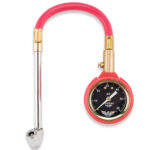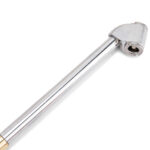- 20 years of experience
- Distributor Maxtrax & Front Runner
- We Ship International
- Store Locator
- Download Brochure


Maintaining Control, Mile After Mile
Underinflated tires can lead to a cascade of problems. They increase rolling resistance, which translates to lower fuel economy. Additionally, improper inflation can cause uneven tire wear, leading to premature replacement. More importantly, underinflated tires can compromise handling and stability, especially in critical situations like braking or cornering.
The AOR Analog Tire Gauge is your trusted companion for maintaining optimal tire pressure. Its easy-to-use design allows for quick and accurate pressure readings, empowering you to ensure your vehicle performs at its peak and prioritize safety on every journey.
Key Features of the AOR Analog Tire Gauge :
Taking Precise Measurements: A Step-by-Step Guide
Additional Tips for Maintaining Optimal Tire Pressure :
Frequently Asked Questions: AOR Analog Tire Gauge
Q: What is the pressure range of the AOR Analog Tire Gauge?
A: The AOR Analog Tire Gauge typically has a pressure range of 0-100 PSI (0-6.9 bar), which caters to most passenger cars, SUVs, and light trucks.
Q: What is the accuracy of the AOR Analog Tire Gauge?
A: The AOR Analog Tire Gauge is designed for general use and offers a reliable indication of tire pressure. While accuracy can vary slightly between models, most gauges boast an accuracy of +/- 2 PSI (+/- 0.14 bar).
Q: Does the AOR Analog Tire Gauge feature a pressure bleed valve?
A: No, the AOR Analog Tire Gauge relies on a simple pressure release button on the gauge itself for controlled air release. This allows for user-controlled deflation for more precise adjustments compared to a fixed pressure bleed valve.
What is the difference between an analog and a digital tire gauge?
A: Analog gauges, like the AOR Analog Tire Gauge, use a dial with a needle to display pressure readings. They are generally more affordable and simpler to operate. Digital gauges, on the other hand, display pressure electronically on a screen. They can offer additional features like pressure history or backlighting but tend to be more expensive.
Q: How can I care for my AOR Analog Tire Gauge to ensure its longevity?
A: Here are some tips for maintaining your AOR Analog Tire Gauge:
| AOR | Easy-to-Read Analog Dial for Quick and Accurate Pressure Checks |
|---|
94.50 AED
1 in stock
Ensuring proper tire pressure is crucial for any driver. It impacts everything from fuel efficiency and handling to safety and tread wear. The AOR Analog Tire Gauge empowers you to take charge of your vehicle’s tire health, providing a simple and reliable way to measure pressure and maintain optimal inflation.